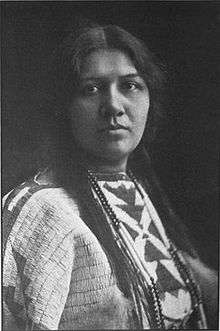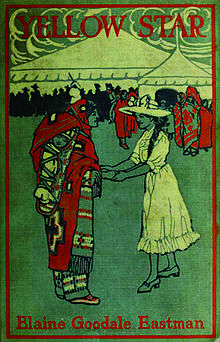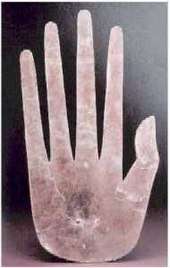Angel De Cora
Angel De Cora Dietz (1871–1919) was a Winnebago painter, illustrator, Native American rights advocate, and teacher at Carlisle Indian School. She was the best known Native American artist before World War I.[1]
Angel De Cora | |
|---|---|
 Angel De Cora | |
| Born | Hinook-Mahiwi-Kalinaka May 3, 1871 |
| Died | February 6, 1919 (aged 47) |
| Nationality | Ho-Chunk |
| Known for | Painting & Illustration |
| Movement | Tonalism |
Background
Angel De Cora Dietz or Hinook-Mahiwi-Kalinaka (Fleecy Cloud Floating in Place), was born at the Winnebago Agency in Dakota County (now Thurston), Nebraska, on May 3, the daughter of David Tall Decora, a Ho-Chunk (Winnebago) of French ancestry and a son of the Little Decorah, a hereditary chief. Angel was born into the Thunderbird clan; her English and Ho-Chunk names were chosen by a relative who was asked to name her, opened the Bible, and the word "angel" caught her eye. Her mother was a member of the influential LaMere family.[2][3] She was kidnapped at a young age from the Agency, and sent to school in Hampton, Virginia. "A strange white man appeared on the reservation and asked her, through an interpreter, if she would like to ride on a steam car; with six other children, she decided to try it, and when the ride was ended she found herself in Hampton. '[It was] three years later when I returned to my mother' says Angel De Cora. 'she told me that for months she wept and mourned for me. My father and the old chief and his wife had died, and with them the old Indian life was gone.'"[3]
As granddaughter to the chief of the Winnebago tribe, De Cora existed in a position of influence since "among most plains people, power and cultural knowledge were accumulated by and dispensed through females"[4] (35). Although De Cora's mother was French in origin, De Cora would be expected to follow in her grandmothers footsteps in passing along cultural practices. "During the summers we lived on the Reservation, my mother cultivating her garden and my father playing the chief's son. During the winter we used to follow the chase away off the Reservation, along rivers and forests. My father provided not only for his family then, but his father's also. We were always moving camp. As a child, my life was ideal. In all my childhood I never received a cross word from any one, but nevertheless, my training was incessant. About as early as I can remember, I was lulled to sleep night after night by my father's or grandparent's recital of laws and customs that had regulated the daily life of my grandsires for generations and generations, and in the morning I was awakened by the same counselling. Under the influence of such precepts and customs, I acquired the general bearing of a well-counselled Indian child, rather reserved, respectful, and mild in manner."[5]
Education
Taken from her family and placed into the Hampton Normal and Agricultural Institute, Hinook/de Cora was to accomplish the U.S. federal government's vision of "educating Indian girls in the hope that women trained as good housewives would help their mates assimilate" into U.S. mainstream culture (272).[6] De Cora studied at a local preparatory school in Hampton, Virginia, working for a local family.[3] Afterwards De Cora was educated at Burnham Classical School for Girls. She then studied art at Smith College. She studied specifically illustration at Drexel Institute (now Drexel University) and also studied at the Cowles Art School in Boston.[7]
Personal
De Cora was married to William Henry "Lone Star" Dietz (Wicarhpi Isnala), who claimed Dakota and German descent but his true identity remains highly controversial.[8] Dietz also taught at the Carlisle Indian School. He and De Cora met at the St. Louis World's Fair in 1904.[3] In addition to his art, Dietz was a notable football player, and in 1915 he became head coach of Washington State; he later was the first head coach of the Washington Redskins.
Artwork
At the beginning of her career, De Cora developed her tonalist style through the influence of her instructor Dwight William Tryon. The Tonalist movement "focused on landscapes and imbued their works with an overall softness to simulate mist or fog in the atmosphere."[9] In her tonalist art work, De Cora painted firelight to illuminate warm memories of her childhood life on the Nebraska plains after she settled far from home in the east".[10] Her oil Painting, "for an Indian school exhibit, for the Pan-American Exposition in Buffalo, New York"[11] demonstrates the technical prowess and emotional depth of her art. As she began to work with illustrator Howard Pyle, her style incorporated more illustration, and he encouraged her to visit the Fort Berthold Reservation in North Dakota in order to reconnect her to Native and Indigenous customs.[9]
De Cora created the title-page designs for Natalie Curtis's The Indians' Book, a collection of Native American songs, stories, and artwork first published in 1907.[12]
Towards the end of her career, De Cora and her husband taught art at the Carlisle Indian Industrial School in Carlisle, Pennsylvania.[3]
Unfortunately not much of De Cora's original paintings remain, but she illustrated her own stories published in Harper's Magazine and illustrated books. The 1911 Yellow Star: A Story of East West, by Elaine Goodale Eastman features illustrations by De Cora and her husband, William Henry Dietz. Her illustrations are rare for her time period because she portrayed Native Americans wearing contemporary clothing.
In some cases, De Cora is not included in the canon of significant Native American artists, as her artwork is now seen as "too western in execution to be considered authentic Native American art."[13] However, "in her day, the public crowned Angel 'the first real Indian artist.'"[13]
Group Exhibitions
- 2019: Hearts of Our People: Native Women Artists, Minneapolis Institute of Art, Minneapolis, MN[9]
Death
Angel De Cora contracted pneumonia, and she died in the Cooley Dickinson Hospital in Northampton, Massachusetts on 6 February 1919. She is buried at the Bridge Street Cemetery.[14]
Gallery

cover illustration by De Cora, 1911 
Frontispiece by De Cora and Dietz 
Illustration by De Cora and Dietz
Notes
- Hutchinson, 740
- Peyer 325
- Hexom, Charles P. (1913). Indian History of Winneshiek County. Decorah, Iowa: Bailey and Sons.
- Spack, Ruth (1997). "Re-visioning Siouz women: Zitkala-Sa's revolutionary American Indian Stories". Legacy. 14: 25–42.
- Kilinaka, Hinook-Mahiwi- (1910). Angel de Cora: An Autobiography. https://web.archive.org/web/20110112035638/http://etext.lib.virginia.edu/etcbin/toccer-new2?id=DecAnge.sgm&images=images/modeng&data=/texts/english/modeng/parsed&tag=public&part=1&division=div1: University of Virginia, Library Website.CS1 maint: location (link)
- Hutchinson, Elizabeth (2001). "Modern Native American art: Angel DeCora's transcultural aesthetics". The Art Bulletin New York (83): 740–756.
- Tom Holm. The Great Confusion in Indian Affairs: Native Americans and Whites in the Progressive Era (Austin: University of Texas Press, 2005) p. 98
- Linda M. Waggoner, "On Trial The Washington R*dskins' Wily Mascot: Coach William Lone Star Dietz", Montana: The Magazine of Western History, Spring 2013, pp. 24-47. Available at http://nmai.si.edu/sites/1/files/pdf/seminars-symposia/WaggonerWEBSpr2013.pdf
- Hearts of our people : Native women artists. Ahlberg Yohe, Jill,, Greeves, Teri,, Silver, Laura (Editor),, Feldman, Kaywin,, Minneapolis Institute of Art,, Frist Art Museum (Nashville, Tenn.). Minneapolis, Minnesota. 2019-05-17. p. 285. ISBN 9780295745794. OCLC 1057740182.CS1 maint: others (link)
- Waggoner, xiii
- Waggoner, 101
- , "Angel De Cora and an Innovative Use of Indian Art," at NatalieCurtis.org.
- Waggoner, Linda M. (2008). Fire light : the life of Angel De Cora, Winnebago artist. Norman: University of Oklahoma Press. pp. xxv. ISBN 978-0806139548. OCLC 212893546.
- Waggoner, 250
References
| Library resources about Angel De Cora |
| By Angel De Cora |
|---|
- Peyer, Bernd. American Indian Nonfiction: An Anthology of Writings, 1760s-1930s . Norman: University of Oklahoma Press, 2007. ISBN 978-0-8061-3798-8.
- Hutchinson, Elizabeth. "Modern Native American Art: Angel DeCora's Transcultural Aesthetics." Art Bulletin. Vol. 83, 4. Dec. 2001: 740-756.
- Waggoner, Linda M. Firelight: The Life of Angel De Cora, Winnebago Artist. Norman: University of Oklahoma Press, 2008. ISBN 978-0-8061-3954-8.
